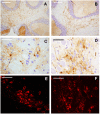Effects of a copper-deficient diet on the biochemistry, neural morphology and behavior of aged mice
- PMID: 23071712
- PMCID: PMC3468563
- DOI: 10.1371/journal.pone.0047063
Effects of a copper-deficient diet on the biochemistry, neural morphology and behavior of aged mice
Abstract
Copper dyshomeostasis has been suggested as an aetiological risk factor for some neurodegenerative diseases, such as Alzheimer's disease. However, the precise mechanism at the base of this involvement is still obscure. In this work, we show the effects of a copper-deficient diet in aged CD1 mice and the influence of such a diet on: a) the concentration of various metal ions (aluminium, copper, iron, calcium, zinc) in the main organs and in different brain areas; b) the alteration of metallothioneins I-II and tyrosine hydroxylase immunopositivity in the brain; c) behavioural tests (open field, pole, predatory aggression, and habituation/dishabituation smell tests). Our data suggested that the copper-deficiency was able to produce a sort of "domino effect" which altered the concentration of the other tested metal ions in the main organs as well as in the brain, without, however, significantly affecting the animal behaviour.
Conflict of interest statement
Figures








Similar articles
-
Zinc or copper deficiency-induced impaired inflammatory response to brain trauma may be caused by the concomitant metallothionein changes.J Neurotrauma. 2001 Apr;18(4):447-63. doi: 10.1089/089771501750171056. J Neurotrauma. 2001. PMID: 11336445
-
Roles of metallothionein in copper homeostasis: responses to Cu-deficient diets in mice.J Inorg Biochem. 2002 Jan 15;88(2):173-82. doi: 10.1016/s0162-0134(01)00376-2. J Inorg Biochem. 2002. PMID: 11803037
-
Effect of dietary or genetic copper deficiency on brain catecholamines, trace metals and enzymes in mice and rats.J Nutr. 1982 Sep;112(9):1706-17. doi: 10.1093/jn/112.9.1706. J Nutr. 1982. PMID: 6286908
-
[Interaction of iron, zinc and copper in the body of animals and humans].Rocz Panstw Zakl Hig. 1989;40(4-6):302-12. Rocz Panstw Zakl Hig. 1989. PMID: 2700243 Review. Polish.
-
Metallothioneins in Prion- and Amyloid-Related Diseases.J Alzheimers Dis. 2016;51(3):637-56. doi: 10.3233/JAD-150984. J Alzheimers Dis. 2016. PMID: 26923022 Review.
Cited by
-
Deregulation of subcellular biometal homeostasis through loss of the metal transporter, Zip7, in a childhood neurodegenerative disorder.Acta Neuropathol Commun. 2014 Feb 28;2:25. doi: 10.1186/2051-5960-2-25. Acta Neuropathol Commun. 2014. PMID: 24581221 Free PMC article.
-
Age-Related In Vivo Structural Changes in the Male Mouse Olfactory Bulb and Their Correlation with Olfactory-Driven Behavior.Biology (Basel). 2023 Feb 28;12(3):381. doi: 10.3390/biology12030381. Biology (Basel). 2023. PMID: 36979073 Free PMC article.
-
The Role of Fe, Zn, and Cu in Pregnancy.Biomolecules. 2020 Aug 12;10(8):1176. doi: 10.3390/biom10081176. Biomolecules. 2020. PMID: 32806787 Free PMC article. Review.
-
Localization of Free and Bound Metal Species through X-Ray Synchrotron Fluorescence Microscopy in the Rodent Brain and Their Relation to Behavior.Brain Sci. 2019 Mar 28;9(4):74. doi: 10.3390/brainsci9040074. Brain Sci. 2019. PMID: 30925761 Free PMC article. Review.
References
-
- White AR, Barnham KJ, Bush AI (2006) Metal homeostasis in Alzheimer’s disease. Expert Rev Neurother 6: 711–722. - PubMed
-
- Drago D, Bolognin S, Zatta P (2008) Role of metal ions in the abeta oligomerization in Alzheimer’s disease and in other neurological disorders. Curr Alzheimer Res 5: 500–507. - PubMed
-
- Zatta P, Frank A (2007) Copper deficiency and neurological disorders in man and animals. Brain Res Rev 54: 19–33. - PubMed
Publication types
MeSH terms
Substances
LinkOut - more resources
Full Text Sources
Medical

